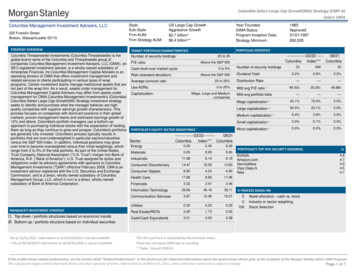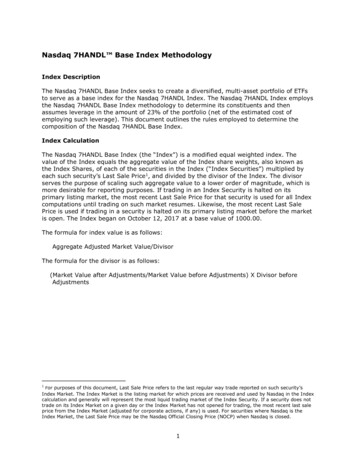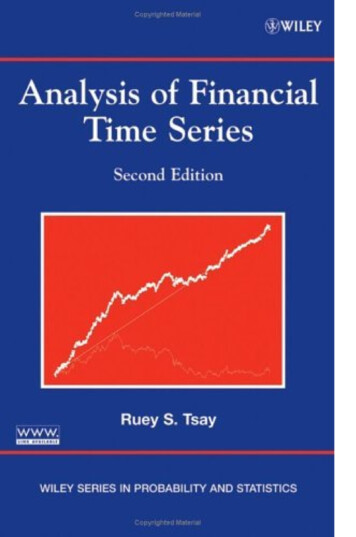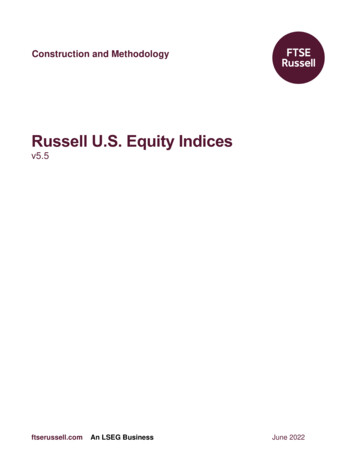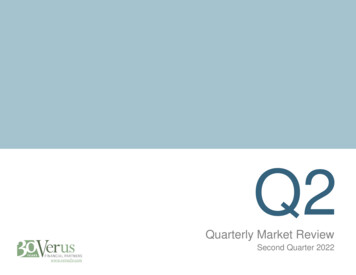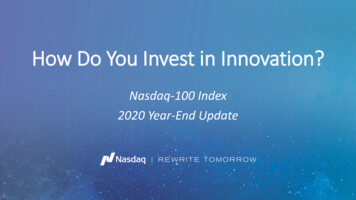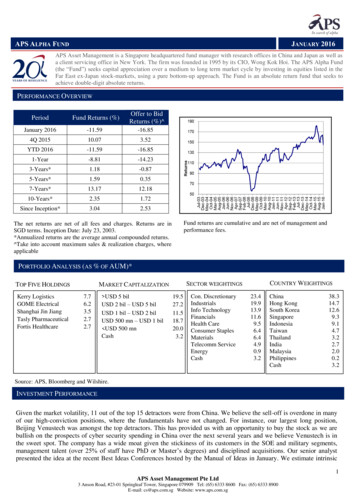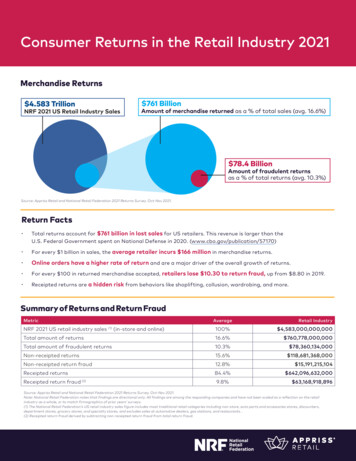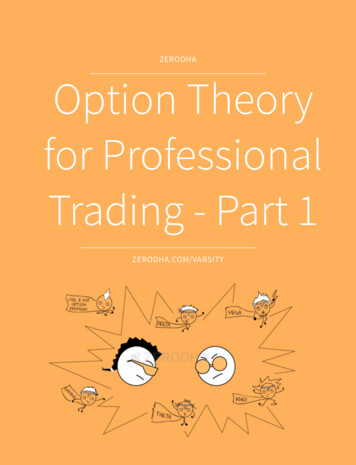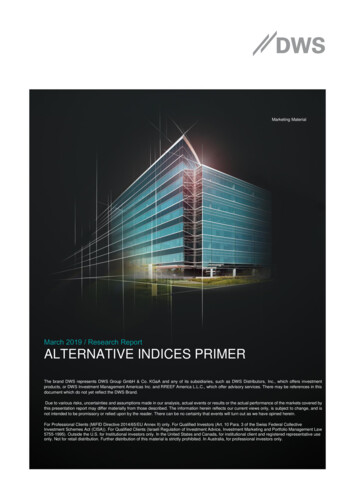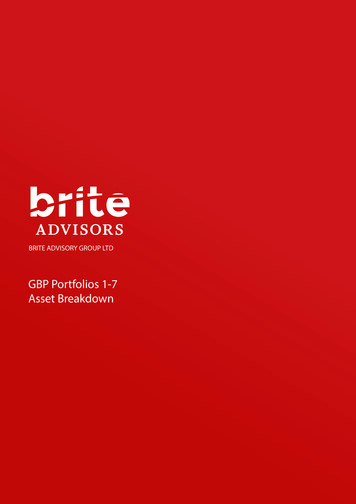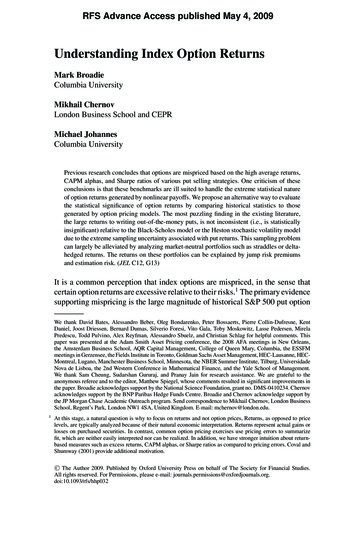
Transcription
RFS Advance Access published May 4, 2009Understanding Index Option ReturnsMark BroadieColumbia UniversityMikhail ChernovLondon Business School and CEPRMichael JohannesColumbia UniversityPrevious research concludes that options are mispriced based on the high average returns,CAPM alphas, and Sharpe ratios of various put selling strategies. One criticism of theseconclusions is that these benchmarks are ill suited to handle the extreme statistical natureof option returns generated by nonlinear payoffs. We propose an alternative way to evaluatethe statistical significance of option returns by comparing historical statistics to thosegenerated by option pricing models. The most puzzling finding in the existing literature,the large returns to writing out-of-the-money puts, is not inconsistent (i.e., is statisticallyinsignificant) relative to the Black-Scholes model or the Heston stochastic volatility modeldue to the extreme sampling uncertainty associated with put returns. This sampling problemcan largely be alleviated by analyzing market-neutral portfolios such as straddles or deltahedged returns. The returns on these portfolios can be explained by jump risk premiumsand estimation risk. (JEL C12, G13)It is a common perception that index options are mispriced, in the sense thatcertain option returns are excessive relative to their risks.1 The primary evidencesupporting mispricing is the large magnitude of historical S&P 500 put optionWe thank David Bates, Alessandro Beber, Oleg Bondarenko, Peter Bossaerts, Pierre Collin-Dufresne, KentDaniel, Joost Driessen, Bernard Dumas, Silverio Foresi, Vito Gala, Toby Moskowitz, Lasse Pedersen, MirelaPredescu, Todd Pulvino, Alex Reyfman, Alessandro Sbuelz, and Christian Schlag for helpful comments. Thispaper was presented at the Adam Smith Asset Pricing conference, the 2008 AFA meetings in New Orleans,the Amsterdam Business School, AQR Capital Management, College of Queen Mary, Columbia, the ESSFMmeetings in Gerzensee, the Fields Institute in Toronto, Goldman Sachs Asset Management, HEC-Lausanne, HECMontreal, Lugano, Manchester Business School, Minnesota, the NBER Summer Institute, Tilburg, UniversidadeNova de Lisboa, the 2nd Western Conference in Mathematical Finance, and the Yale School of Management.We thank Sam Cheung, Sudarshan Gururaj, and Pranay Jain for research assistance. We are grateful to theanonymous referee and to the editor, Matthew Spiegel, whose comments resulted in significant improvements inthe paper. Broadie acknowledges support by the National Science Foundation, grant no. DMS-0410234. Chernovacknowledges support by the BNP Paribas Hedge Funds Centre. Broadie and Chernov acknowledge support bythe JP Morgan Chase Academic Outreach program. Send correspondence to Mikhail Chernov, London BusinessSchool, Regent’s Park, London NW1 4SA, United Kingdom. E-mail: mchernov@london.edu.1At this stage, a natural question is why to focus on returns and not option prices, Returns, as opposed to pricelevels, are typically analyzed because of their natural economic interpretation. Returns represent actual gains orlosses on purchased securities. In contrast, common option pricing exercises use pricing errors to summarizefit, which are neither easily interpreted nor can be realized. In addition, we have stronger intuition about returnbased measures such as excess returns, CAPM alphas, or Sharpe ratios as compared to pricing errors. Coval andShumway (2001) provide additional motivation. C The Author 2009. Published by Oxford University Press on behalf of The Society for Financial Studies.All rights reserved. For Permissions, please e-mail: 3/rfs/hhp032
The Review of Financial Studiesreturns. For example, Bondarenko (2003) reports that average at-the-money(ATM) put returns are 40%, not per annum, but per month, and deep outof-the-money (OTM) put returns are 95% per month. Average option returnsand CAPM alphas are statistically significant, with p-values close to zero, andSharpe ratios are larger than those of the underlying index.2There are three obvious factors to consider when interpreting these results.Option returns are highly nonnormal and metrics assuming normality, suchas CAPM alphas or Sharpe ratios, are inappropriate.3 Additionally, averageput returns should be negative due to the leverage inherent in options and thepresence of priced risks. Finally, options have only traded for a short periodof time, and it is difficult to assess the statistical significance of option returnsdue to the short time spans and nonnormality of option returns. Together, thesefactors raise questions about the usual procedures of applying standard assetpricing metrics to analyze option returns.In this paper, we use option pricing models as a benchmark to assess theevidence for index option mispricing and address the issues raised above.Option returns computed from formal option pricing models automaticallyreflect the leverage and kinked payoffs of options, anchor hypothesis testsat appropriate null values, provide a framework for assessing the impact ofrisk premiums, and provide a mechanism for assessing statistical uncertaintyvia finite-sample simulations. Ideally, an equilibrium model over economicfundamentals, such as consumption or dividends, would be used to assess theevidence for mispricing. However, as argued by Bates (2008) and Bondarenko(2003), such an explanation is extremely challenging inside the representativeagent framework. This is not a surprise, since these models have difficultiesexplaining not only the low-frequency features of stock returns (e.g., the equitypremium or excess volatility puzzles) but also high-frequency movements suchas price jumps, high-frequency volatility fluctuations, or the leverage effect.We address a more modest, but still important, goal of understanding the pricing of options relative to the underlying index, as opposed to pricing options relative to the underlying fundamental variables. To do this, we use affine-jump diffusion models of stock index returns. These models account for the key driversof equity returns and option prices such as diffusive price shocks, stochasticvolatility, and price jumps. The key step is one of calibration: we calibrate eachmodel to fit the observed behavior of equity index returns over the sample forwhich option returns are available. In particular, this approach implies that ourmodels replicate the historically observed equity premium and volatility.2The returns are economically significant, as investors endowed with a wide array of utility functions find largecertainty equivalent gains from selling put options (e.g., Driessen and Maenhout 2004b; Santa-Clara and Saretto2007).3The shortcomings of these metrics have been understood for a long time (see Glosten and Jagannathan 1994;Goetzmann et al. 2007; Grinblatt and Titman 1989; and Leland 1999, among others). However, their use is stillpervasive both in the industry and in academia.2
Understanding Index Option ReturnsMethodologically, we proceed using two main tools. First, we show thatexpected option returns (EORs) can be computed analytically, allowing us toexamine the quantitative impact of different factors and parameter values onoption returns. In particular, EORs anchor null hypothesis values when testingwhether average option returns are significantly different from those generatedby a given null model. Second, we simulate index sample paths to constructexact finite-sample distributions for the statistics analyzed. This procedureaccounts for both the small sample sizes (on the order of 200 months) andthe highly skewed and nonnormal nature of option return distributions. It alsoallows us to assess the statistical uncertainty of commonly used asset pricingbenchmarks and statistics, such as average returns, CAPM alphas, or Sharperatios.4Empirically, we present a number of interesting findings. We first analyze putreturns, given their importance in the recent literature, and begin with the standard Black and Scholes (1973) and Heston (1993) stochastic volatility models.Although these models are too simple to accurately describe option prices, theyprovide key insights for understanding and evaluating option returns. Our firstresult is that average returns, CAPM alphas, and Sharpe ratios for deep OTMput returns are statistically insignificant when compared to the Black-Scholesmodel. Thus, one of the most puzzling statistics in the literature, the largeaverage OTM put returns, is not inconsistent with the Black-Scholes model.Moreover, there is little evidence that put returns of any strike are inconsistentwith Heston’s (1993) stochastic volatility (SV) model, assuming no diffusivestochastic volatility risk premiums (i.e., the evolution of volatility under theobjective, P, and the risk-neutral, Q, measures are the same).We interpret these findings not as evidence that the Black-Scholes or Hestonmodels are correct—we know they can be rejected on other grounds—but ratheras highlighting the statistical difficulties present when analyzing option returns.Short samples and complicated option return distributions imply that standardstatistics are so noisy that little can be concluded by analyzing option returns.It is well known that it is difficult to estimate the equity premium, and thisuncertainty is only magnified when estimating average put returns.This implies that tests using put option returns are not very informative aboutoption mispricing, and we next turn to returns of alternative option portfoliostrategies such as ATM straddles, crash-neutral straddles, covered puts, putspreads, and delta-hedged puts. These portfolios are more informative becausethey either reduce the exposure to the underlying index (straddles and deltahedged puts) or dampen the effect of rare events (crash-neutral straddles andput spreads).Of all of these portfolios, straddles are quite useful since straddles do notrequire a model to determine the initial portfolio position (unlike delta-hedged4The results are similar using alternative measures, such as Leland’s alpha (Leland 1999) or the manipulationproof performance measure (Goetzmann et al. 2007).3
The Review of Financial Studiesputs) and the returns are approximately market neutral. Straddles are also moreinformative than individual puts, since average straddle returns are highly significant when compared to returns generated from the Black-Scholes modelor a baseline stochastic volatility model without a diffusive volatility risk premium. The source of this significance is the well-known wedge between theATM-implied volatility and the subsequent realized volatility.5 As argued byPan (2002) and Broadie, Chernov, and Johannes (2007), it is unlikely that a diffusive stochastic volatility risk premium could generate this wedge because theoptions are short-dated, and a stochastic volatility risk premium would mainlyimpact longer-dated options.We consider two mechanisms to generate wedges between realized and implied volatility in jump-diffusion models: jump risk premiums and estimationrisk. The jump risk explanation uses the jump risk corrections implied by anequilibrium model as a simple device for generating Q-measure jump parameters, given P-measure parameters. Consistent with our original intent, such anadjustment does not provide an equilibrium explanation, as we calibrate theunderlying index model to match the overall equity premium and volatility ofreturns. In the case of estimation risk, we assume that investors account for theuncertainty in spot volatility and parameters when pricing options.Both of these explanations generate option returns that are broadly consistentwith those observed historically. For example, average put returns are matchedpointwise and the average returns of straddles, put spreads, crash-neutral straddles, and delta-hedged portfolios are all statistically insignificant.These results indicate that, at least for our parameterizations, option returnsare not puzzling relative to the benchmark models. Option and stock returnsmay remain puzzling relative to consumption and dividends, but there is littleevidence for mispricing relative to the underlying stock index.The rest of the paper is outlined as follows. Section 1 outlines our methodological approach. Section 2 discusses our dataset and summarizes the evidencefor put mispricing. Section 3 illustrates the methodology based on the BlackScholes and Heston models. Section 4 investigates strategies based on optionportfolios. Section 5 illustrates how a model with stochastic volatility and jumpsin prices generate realistic put and straddle returns. Conclusions are given inSection 6.1. Our ApproachWe analyze returns to a number of option strategies. In this section, we discusssome of the concerns that arise in analyzing option returns, and then discuss ourapproach. To frame the issues, we focus on put option returns, but the resultsand discussion apply more generally to portfolio strategies such as put spreads,straddles, or delta-hedged returns.5Over our sample, ATM-implied volatility averaged 17% and the realized volatility was 15%.4
Understanding Index Option ReturnsHold-to-expiration put returns are defined asprt,T (K St T ) 1,Pt,T (K , St )(1)where x max(x, 0) and Pt,T (K , St ) is the time-t price of a put option writtenon St , struck at K , and expiring at time t T. Hold-to-expiration returns aretypically analyzed both in academic studies and in practice for two reasons.First, option trading involves significant costs, and strategies that hold untilexpiration incur these costs only at initiation. For example, ATM (deep OTM)index option bid-ask spreads are currently on the order of 3–5% (10%) of theoption price. The second reason, discussed fully in Section 2, is that highfrequency option returns generate a number of theoretical and statistical issuesthat are avoided using monthly returns.The goal of this literature is to assess whether or not option returns areexcessive, either in absolute terms or relative to their risks. Existing approachesrely on statistical models, as discussed in Appendix A. For example, it iscommon to compute average returns, CAPM alphas, or Sharpe ratios. Strategiesthat involve writing options generally deliver higher average returns than theunderlying asset, have economically and statistically large CAPM alphas, andhave higher Sharpe ratios than the market.How should these results be interpreted? Options are effectively leveragedpositions in the underlying asset (which typically has a positive expected return), so call (put) options have higher (lower) expected returns than the underlying. For example, expected put option returns are negative, which impliesthat standard t-tests of average option returns that test the null hypothesis thataverage returns are zero are improprely anchored. The precise magnitude ofexpected returns depends on a number of factors that include the specific model,the parameters, and factor risk premiums. In particular, EORs are very sensitiveto both the equity premium and volatility.It is important to control for the option’s exposure to the underlying, which iscommonly done by computing betas using a CAPM-style specification. This approach is motivated by the hedging arguments used to derive the Black-Scholesmodel. According to this model, the link between instantaneous derivativereturns and excess index returns is St f (St ) dStdf (St ) (r δ) dt , rdt f (St )f (St ) StSt(2)where r is the risk-free rate, f (St ) the derivative price, and δ the dividend rate on the underlying asset. This implies that instantaneous changesin the derivative’s price are linear in the index returns, d St /St , and instantaneous option returns are conditionally normally distributed. This instantaneous5
The Review of Financial StudiesCAPM is often used to motivate an approximate linear factor model for optionreturnsf (St T ) f (St ) αt,T βt,Tf (St ) St T St rTSt εt,T .These linear factor models are used to adjust for leverage, via βt,T , and asa pricing metric, via αt,T . In the latter case, αT 0 is often interpreted asevidence of either mispricing or risk premiums.As shown empirically and theoretically in Appendix B, standard optionpricing models (including the Black-Scholes model) generate population valuesof αt,T that are different from zero.6 In the Black-Scholes model, this is dueto time discretization, but in more general jump-diffusion models, αt,T can benonzero for infinitesimal intervals due to the presence of jumps. This impliesthat it is inappropriate to interpret a nonzero αt,T as evidence of mispricing.Similarly, Sharpe ratios account for leverage by scaling average excess returnsby volatility, which provides an appropriate metric when returns are normallydistributed or if investors have mean-variance preferences. Sharpe ratios areproblematic in our setting because option returns are highly nonnormal, evenover short time intervals.Our approach is different. We view these intuitive metrics (average returns,CAPM alphas, and Sharpe ratios) through the lens of formal option pricing models. The experiment we perform is straightforward: we compare theobserved values of these statistics in the data to those generated by optionpricing models such as Black-Scholes and extensions incorporating jumps orstochastic volatility. The use of formal models plays two roles: it provides anappropriate null value for anchoring hypothesis tests, and it provides a mechanism for dealing with the severe statistical problems associated with optionreturns.1.1 ModelsWe consider nested versions of a general model with mean-reverting stochasticvolatility and lognormally distributed Poisson-driven jumps in prices. Thismodel, proposed by Bates (1996) and Scott (1997) and referred to as the SVJmodel, is a common benchmark (see, e.g., Andersen, Benzoni, and Lund 2002;Bates 1996; Broadie, Chernov, and Johannes 2007; Chernov et al. 2003; Eraker2004; Eraker, Johannes, and Polson 2003; Pan 2002). As special cases of themodel, we consider the Black and Scholes (1973) model, the Merton (1976)jump-diffusion model, and the Heston (1993) stochastic volatility model.6Leland (1999) makes this point in the context of the Black-Scholes model.6
Understanding Index Option ReturnsThe model assumes that the ex-dividend index level St and its spot varianceVt evolve under the physical (or real-world) P-measure according to dSt (r μ δ)St dt St Vt dW st (P) d Nt (P)sSτ j e Z j (P) 1 λP μP St dt,(3)j 1 d Vt κPv θPv Vt dt σv Vt dW vt (P),(4)where r is the risk-free rate, μ is the cum-dividend equity premium,δ is the dividend yield, Wts and Wtv are two correlated Brownian motions (E[Wts Wtv ] ρt), Nt (P) Poisson (λP t), Z sj (P) N (μPz , (σPz )2 ), andμP exp (μPz (σPz )2 /2) 1. Black-Scholes is a special case with no jumps(λP 0) and constant volatility (V0 θPv , σv 0), Heston’s model is a special case with no jumps, and Merton’s model is a special case with constantvolatility. When volatility is constant, we use the notation Vt σ.Options are priced using the dynamics under the risk-neutral measure Q: dSt (r δ)St dt St Vt dW st (Q) d Nt (Q)sSτ j e Z j (Q) 1 λQ μQ St dt,(5)j 1 Q vdV t κQv θv Vt dt σv Vt dW t (Q),(6)Q 2where Nt (Q) Poisson (λQ t), Z j (Q) N (μQz , (σz ) ), Wt (Q) are BrownianQPmotions, and μ is defined analogously to μ . The diffusive equity premiumis μc , and the total equity premium is μ μc λP μP λQ μQ . We generallyrefer to a nonzero μ as a diffusive risk premium. Differences between the riskneutral and real-world jump and stochastic volatility parameters are referred toas jump or stochastic volatility risk premiums, respectively.Both the parameters θv and κv can potentially change under the risk-neutralmeasure (Cheredito, Filipovic, and Kimmel 2007). We explore changes in θPvPand constrain κQv κv , because, as discussed below, average returns are notsensitive to empirically plausible changes in κPv . Changes of measure for jumpprocesses are more flexible than those for diffusion processes. We assume thatthe jump size distribution is lognormal under Q with potentially different meansand variances. Below we discuss in detail two mechanisms, risk premiums andestimation risk, to calibrate the risk-neutral parameters.1.2 Methodological frameworkMethodologically, we rely on two main tools: analytical formulas for expectedreturns and Monte Carlo simulation to assess statistical significance.7
The Review of Financial Studies1.2.1 Analytical expected option returns.given byExpected put option returns are p E P [(K St T ) ]E P [(K St T ) ] 1 Q t 1.E tP rt,T tPt,T (St , K )E t [e r T (K St T ) ](7)From this expression, it is clear that any model that admits “analytical” optionprices, such as affine models, will allow EORs to be computed explicitly sinceboth the numerator and denominator are known analytically. Higher momentscan also be computed. Surprisingly, despite a large literature analyzing optionreturns, the fact that EORs can be easily computed has neither been noted norapplied.7EORs do not depend on St . To see this, define the initial moneyness of theoption as κ K /St . Option homogeneity implies that p E tP rt,T E tP [(κ Rt,T ) ]E tQ [e r T (κ Rt,T ) ] 1,(8)where Rt,T St T /St is the gross index return.8 EORs depend only on themoneyness, maturity, interest rate, and distribution of index returns.9This formula provides exact EORs for finite holding periods regardless of therisk factors of the underlying index dynamics and without using CAPM-styleapproximations. These analytical results are primarily useful as they allow usto assess the exact quantitative impact of risk premiums or parameter configurations. Equation (7) implies that the gap between the P and Q probabilitymeasures determines EORs, and the magnitude of the returns is determined bythe relative shape and location of the two probability measures.10 In modelswithout jump or stochastic volatility risk premiums, the gap is determined bythe fact that the P and Q drifts differ by the equity risk premium. In modelswith priced stochastic volatility or jump risk, both the shape and location ofthe distribution can change, leading to more interesting patterns of expectedreturns across different moneyness categories.7This result is closely related to that of Rubinstein (1984), who derived it specifically for the Black-Scholes caseand analyzed the relationship between hold-to-expiration and shorter holding period expected returns.8Glosten and Jagannathan (1994) use option homogeneity to benchmark payoff from one dollar invested in amutual fund with unknown asset composition against a portfolio consisting of the index with a payoff of Rt,Tand an option with a payoff (Rt,T κ) . Subsequently, Glosten and Jagannathan use the Black-Scholes modelto value the benchmark portfolio.9When stochastic volatility is present in a model, the expected option returns can be computed analyticallypconditional on the current variance value: E P (rt,T Vt ). The unconditional expected returns can be computedusing iterated expectations and the fact that p p E P rt,T E P rt,T Vt p (Vt ) d Vt .The integral can be estimated via Monte Carlo simulation or by standard deterministic integration routines.10For monthly holding periods, 1 exp (r T ) 1.008 for 0% r 10% and T 1/12 years, so the discountfactor has a negligible impact on EORs.8
Understanding Index Option Returns1.2.2 Finite-sample distribution via Monte Carlo simulation. To assessstatistical significance, we use Monte Carlo simulation to compute the distribution of various returns statistics, including average returns, CAPM alphas, andSharpe ratios. We are motivated by concerns that the use of limiting distributions to approximate the finite-sample distribution is inaccurate in this setting.Our concerns arise due to the relatively short sample and extreme skewnessand nonnormality of option returns.To compute the finite-sample distribution of various option return statistics,we simulate N 215 months (the sample length in the data) of index levelsG 25,000 times using standard simulation techniques. For each month andindex simulation trial, put returns for a fixed moneyness are (g) κ Rt,Tp,(g) 1,(9)rt,T PT (κ)wherePT (κ) Pt,T (St , K ) e r T E tQ [(κ Rt,T ) ],Stt 1, . . . , N and g 1, . . . , G. Average option returns for simulation g usingN months of data arep,(g)rT 1NNp,(g)r.t 1 t,TThe set of G average returns forms the finite-sample distribution. Similarly, wecan construct finite-sample distributions for Sharpe ratios, CAPM alphas, andother statistics of interest for any option portfolio.This parametric bootstrapping approach provides exact finite-sample inference under the null hypothesis that a given model holds. It can be contrastedwith the nonparametric bootstrap, which creates artificial datasets by samplingwith replacement from the observed data. The nonparametric bootstrap, whichessentially reshuffles existing observations, has difficulties dealing with rareevents. In fact, if an event has not occurred in the observed sample, it will neverappear in the simulated finite-sample distribution. This is an important concernwhen dealing with put returns, which are sensitive to rare events.1.3 Parameter estimationWe calibrate our models to fit the realized historical behavior of the underlyingindex returns over our observed sample. Thus, the P-measure parameters areestimated directly from historical index return data, and not consumption ordividend behavior. For parameters in the Black-Scholes model, this calibrationis straightforward, but in models with unobserved volatility or jumps, theestimation is more complicated, as it is not possible to estimate all of theparameters via simple sample statistics.9
The Review of Financial StudiesTable 1P-measure parametersr4.50%PμλμPz5.41%0.91(0.34) 3.25%(1.71)σPz6.00%(0.99) θPv(SV) (0.01) 0.52(0.04)This table reports values of P-measure parameters that we use in our computational examples. Standard errorsfrom the SVJ estimation are reported in parentheses. Parameters are given in annual terms.For all of the models that we consider, the interest rate and equity premiummatch those observed over our sample, r 4.5% and μ 5.4%. Since weanalyze futures returns and futures options, δ r . In each model, we alsoconstrain the total volatility to match the observed monthly volatility of futuresreturns, which was 15%. In the most general model we consider, we do this byimposing that 2 2 15%θPv λP μPz σPzand by modifying θPv appropriately. In the Black-Scholes model, we set theconstant volatility to be 15%.To obtain the values of the remaining parameters, we estimate the SVJmodel using daily S&P 500 index returns spanning the same time period asour options data, from 1987 to 2005. We use MCMC methods to simulate theposterior distribution of the parameters and state variables following Eraker,Johannes, and Polson (2003) and others. The parameter estimates (posteriormeans) and posterior standard deviations are reported in Table 1. The parameterestimates are in line with the values reported in previous studies (see Broadie,Chernov, and Johannes 2007 for a review).Of particular interest for our analysis are the jump parameters. The estimatesimply that jumps are relatively infrequent, arriving at a rate of about λP 0.91per year. The jumps are modestly sized with a mean of 3.25% and a standarddeviation of 6%. Given these values, a “two sigma” downward jump size willbe equal to 15.25%. Therefore, a crash-type move of 15% or less will occurwith a probability of λP ·5%, or approximately once in twenty years.As we discuss in greater detail below, estimating jump intensities and jumpsize distributions is extremely difficult. The estimates are highly dependent onthe observed data and on the specific model. For example, different estimateswould likely be obtained if we assumed that the jump intensity was dependenton volatility (as in Bates 2000 or Pan 2002) or if there were jumps in volatility.Again, our goal is not to exhaustively analyze every potential specification butrather to understand option returns in common specifications and for plausibleparameter values.We discuss the calibration of Q-measure parameters later. At this stage,we only emphasize that we do not use options data to estimate any of the10
Understanding Index Option Returnsparameters. Estimating Q-parameters from option prices for use in understanding observed option returns would introduce a circularity, as we would beexplaining option returns with information extracted from option prices.2. Initial Evidence for Put MispricingWe collect historical data on S&P 500 futures options from August 1987 toJune 2005, a total of 215 months. These options are American, but our statisticsare computed using the European values estimated through the procedure fromBroadie, Chernov, and Johannes (2007). This sample is considerably longerthan those previously analyzed and starts in August of 1987, when one-month“serial” options were introduced. Contracts expire on the third Friday of eachmonth, which implies there are 28 or 35 calendar days to maturity dependingon whether it was a four- or five-week month. We construct representative dailyoption prices using the approach in Broadie, Chernov, and Johannes (2007);details of this procedure are given in Appendix C.Using these prices, we compute option returns for fixed moneyness, measuredby strike divided by the underlying, ranging from 0.94 to 1.02 (in 2% increments). This range covers the most actively traded options (85% of one-monthoption transactions occur in this range). We did not include deeper OTM or ITMstrikes because of miss
options are short-dated, and a stochastic volatility risk premium would mainly impact longer-dated options. We consider two mechanisms to generate wedges between realized and im-plied volatility in jump-diffusion models: jump risk premiums and estimation risk. The jump risk explanation uses the jump risk corrections implied by an
